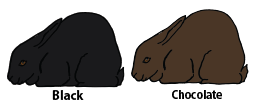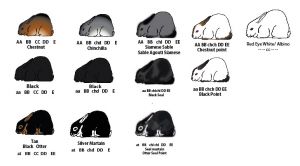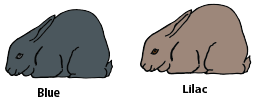Difference between revisions of "Basic Color Genetics"
| Line 47: | Line 47: | ||
D is dominate for no dilution or full Density of color, | D is dominate for no dilution or full Density of color, | ||
d is recessive and | d is recessive and Dilutees the color . | ||
Revision as of 00:14, 4 January 2022
Basic Color Genetics
The five base Alle's that effects the base coat color of the Domestic rabbit.( DISCRIPE THE BASIC DEFEINTION OF EACH, LINK TO NEW PAGE FOR INDEPTH DISCUSSION.)
A- Agouti
The Agouti gene has three variable Alles. Agouti is the most dominate followed by Tan, and then Self is the most recessive.
Agouti locus's - expresses the "wild color" which is the banding of the individual hairs. Banding is dominate , and is expressed by " A" allele. "Self " colored, which has no banding is the recessive allele "a" . If the animal has two recessive alleles it will have a solid colored hair shaft. Their is a third loci on this gene. at: the tan marker. Tan creates a solid pattern on the top of the rabbit with white or tan belly , inner ears , and eye rings. similar to how harlequin breaks up the color into distinct patches , "at" is expressing the solid color of the eumelanin on the top portion of the Rabbit , and the Solid color of the pheomelanin on the bottom.
B-Black/Brown
The B marker has 2 Alle's , Black is Dominate to Brown. The B loci expresses the quality of eumelanin. Eumelanin can be expressed as either Black or Brown, and their are many colors that are created depending on which of these is the base color. Their are also genes that mask or remove the ability for a hair follicle to produce eumelanin, in these cases either no pigment(white) or only pheomelanin(Yellow/Red) are expressed.
C-Color Coverage
there are four alles on the color concentration marker. Full Color, Chinchilla, Shaded/light chinchilla, Himalayan, and Albino.
The Color Concentration Loci has four Alleles.
"C" Full color is Dominate,
"cchd" or "chd" which is Dark Chinchilla, this strips most of the pheomelanin (red/yellow) and it turns grey/white while leaving the eumelanin (black/chocolate) alone.
"cchl"or " chl" Light Chinchilla , strips the pheomelanin (red/yellow) and some of the eumelanin (black/chocolate) giving it a shaded appearance. It can also give the eumelanin a lightning effect turning it a sepia color.
"ch" Himalayan (or Californian) allele , is a temperature sensitive allele that leaves colors at only pointed tips . The parts of the rabbit espoused to the coldest temperatures have the richest darkest colors and the color intensity can change seasonally.
"c" is the most recessive . Two copies of "c" on this allele produce Red Eye Whites. Although "c" this is the most recessive gene, in some ways has the most dominate effect. When "cc" is expressed it prevents both pheomelanin and eumelanin from being expressed, and this then masks all other Loci hiding the rabbits actual coat colors completely.
D-Density
Density Gene has two Alle's, Full Density is dominate, and Dilute is recessive. The representation of The Dominate full Darkness marker is usually defined as " D". While the Dilute , is a higher "brightness" marker is usually defined as "d". This gene can be thought of like the brightness slider under the hue/saturation adjuster in photoshop. Your default image (D) is set to 0, while the Dilute is akin to +50 brightness.
This loci has two Allele D- & dd . The D Loci, effects the Eumelanin of a rabbit on the B locus. A rabbit that has double recessive genes for dilution "dd", will make a Black Rabbit Blue, and a Chocolate Rabbit a Tan/Fawn color called " lilac" in rabbits.
D is dominate for no dilution or full Density of color,
d is recessive and Dilutees the color .
E-Extension
The Extension gene has five separate markers that control the extend of the band of an Agouti rabbit. Ed dominate black the rabbit will appear self as it will extend the color at B to entire hair follicle, Es steel is the second most dominate color, this extends the color at the B loci almost to the tip on an agouti rabbit, so the follicle will be soil 3/4 of the way to the tip with just the tip showing a red/yellow/white coloring. , E-regular extension, this will preset the hair as it is, and Agouti rabbit will have banded color along the hair shaft, and a self or tan rabbit will have a soil hair coloration. ej-Japanese harliquen is a co-dominate recessive gene that expresses patches of alternating color, or Bridling on Agouti coats. ee-is non-extension, it is the opposite of dominate black and hide the color at B on Agouti rabbit extending the tip color to the base . and blocking out all Eumelanin.
This Alle modifies the bands on an Agouti Rabbit .
Ed dominate black. This is the most Dominate Gene on the E loci, it is more Dominate then Es.This gene expresses Full solid color at the B loci Eumelanin . It completely extends the black bands on the Agouti hair shaft with whatever color is present in B. Some Geneticists have theorized that a Double Steel coat can also present as Dominate black, but since the Ed marker has been reported as far back as the 1800's I am including it. I also wonder if my Broken black Buck may actually carry this gene along with E.
Es Steel , A Steel Coat the hair shaft is mostly black with a gold or White/silver Tip, tip color is depended on where the Rabbit can produce pheomelanin or not. A Gold Tipped Steel is a normal presenting pheomelanin, a Silver tipped Steele is most likely a Chinchilla Rabbit at C. Double Steel will extend the pigment of the shafts on some rabbits to make a Agouti look like a self black.
E is the third most dominate gene , It expresses Regular Extension, or normal expression of the colors at the A and B loci
ej Harlequin characterized by alternating patches of banding. These rabbits look Brindled or patched, in the harlequin Breed, the Color is preferred to have a Perfectly Split face between the pheomelanin and eumelanin sides, with the opposite ear colored, and again the opposite front legs, Ideally the rabbit will have a clean checker board like pattern . Very Clean Harlequins with have densely colored coat with clean patches but in co-dominants rabbits bridling and mudding of the patches is common. "ej" expresses itself in 2 base colors.
Magpie, which is a Chinchilla based coat meaning the coat is stripped of the pheomelanin and presents as White, with Black or Chocolate based patches. Japanese , Which expresses the full color pheomelanin Red/Yellow, along with the Black or Brown based patches, both colors ideally will have the same patterning. e Tort/ non-extension the opposite of the Steels with the light part of the Agouti hairs extended to the base. Non-extension strips out the eumelanin from the agouti coat and presents as a yellow/red solid colored rabbit, but it is common for these rabbits to still show the creamy/white underbelly that distinguishes the Agouti.
A Tort is a Self colored rabbit at A, " aa" and it expressed as a Reddish solid coat since the pheomelanin masks the Color at A, but they tend to express the eumelanin with darker points. similar to the Himalayan points, their Nose, Ears, Feet and Tail will be shaded darker.
in-depth references:
Slc7a11 Modulated by POU2F1 is Involved in Pigmentation in Rabbit
https://www.ncbi.nlm.nih.gov/pmc/articles/PMC6566412/
Characterization of the rabbit agouti signaling protein (ASIP) gene: Transcripts and phylogenetic analyses and identification of the causative mutation of the nonagouti black coat color https://www.sciencedirect.com/science/article/pii/S0888754309002559



